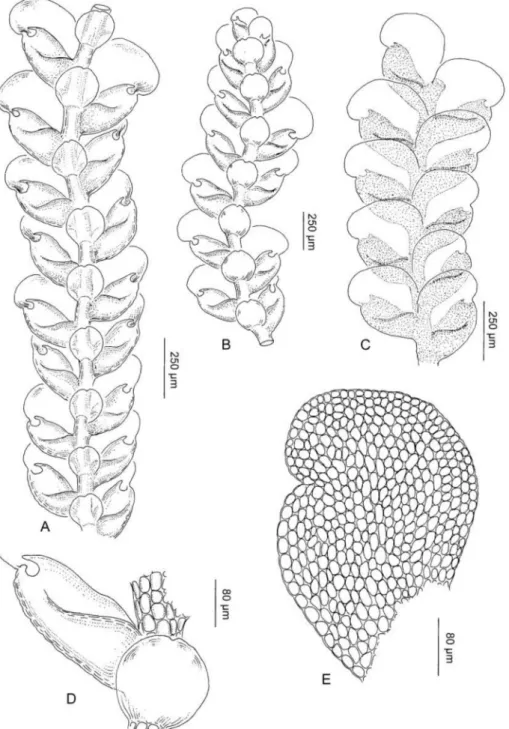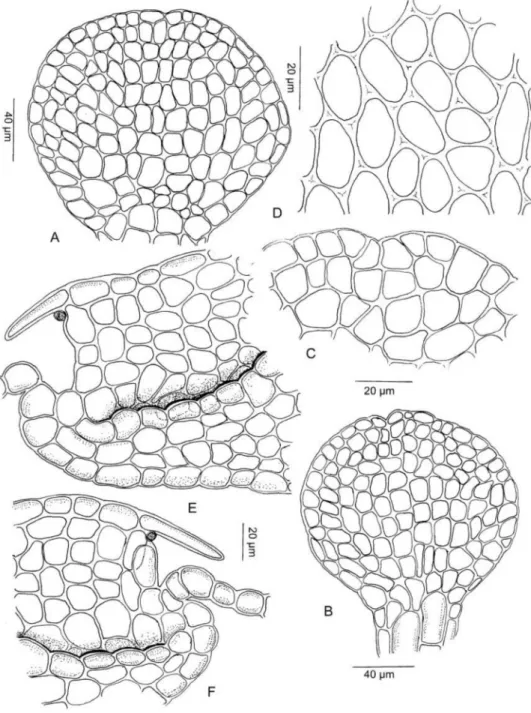CHEILOLEJEUNEA ULUGURICA
(LEJEUNEACEAE, MARCHANTIOPHYTA), A NEW SPECIES FROMTANZANIA
Itambo Malombe
1, Eberhard Fischer
2and Tamás Pócs
31National Museums of Kenya, East African Herbarium, P.O. Box 45166 00100 Nairobi, Kenya, imalombe@museums.or.ke; 2Institute for Integrated Natural Sciences, Dept. of Biology, University of Koblenz-Landau, Universitätsstr. 1
56070 Koblenz Germany, efischer@uni-koblenz.de; 3Eszterházy College, Department of Botany, Eger,Pf. 43, Hungary, H-3301; colura@chello.hu Validation of Cheilolejeunea ulugurica
Cheilolejeunea, conservation, Eastern Arc, endemism, Uluguru, Tanzania Abstract
Cheilolejeunea ulugurica Malombe, Eb.Fisch. & Pócs is a new species affiliated to subg. Cheilolejeunea. One of its closest relatives seems to be Cheilolejeunea chenii from Asia. It is described from the Uluguru Mountains, members of the crystalline Eastern Arc of Tanzania, notorious for its richness in endemic species.
Introduction
Tamás Pócs presumed the possibility of a new species collected by him with his son Bence on the Bondwa peak of Uluguru Mountains in Tanzania in 1985.
The two other authors studied carefully the scanty material and confirmed his assumption, describing and illustrating this species. In an account on some new Cheilolejeunea species Malombe (2009) mentioned the name of Cheilolejeunea ulugurica Malombe, Eb. Fisch. et Pócs and published its detailed illustration with some annotation but without a diagnosis and a detailed description, referring to a paper of the three authors to be published later. The present paper will validate the new species, adding the necessary details.
The new species of Cheilolejeunea(Spruce) Schiffn. is described on the basis of the following morphological characters: the obovato-spathulate nature of the lobe with a lobule occupying its to ¾ length with strongly incurved keel apex, forming very narrow sinus with postical lobe margin, which clearly give the new
24
circumscription of the species from other allied members of subg.
Cheilolejeunea, especially of the closely related Asian Ch. chenii is provided, with some remarks on its ecology and conservation status.
Cheilolejeunea ulugurica Malombe, Eb. Fisch. et Pócs,sp. nov. (Fig. 1, 2) Differt a Cheilolejeunea chenii R.L. Zhu & M.L. So foliis falcatis angulis acutioribus inter carina et apice lobi, lobulis angustioribus marginibus liberis cellulis pluribus et marginibus distalibus solum 2-3 cellulis composita.
Typus : TANZANIA, Uluguru Mts, N side of Bondwa peak, 1650–1880 m, 26 Dec. 1985, B. & T. Pócs, 8565/S, (Holotype: EGR, microslide!).
Description
Plants green in situ turning brown in herbarium, up to 12 mm long. Shoots always mixed with other species, 560–776 µm wide, with few seldom branches.
Stem 64–84µm in diameter. Ventral merophytes of the stem 2 cells (31.5 × 21.7µm in average) wide. Leaves usually imbricate, obovato-spathulate, slightly falcate, spreading from the stem at an angle of 80–130o, 378–488 µm long, 340–
392 µm wide, apex broadly rounded, plane, bends outwards, margin smooth, base flat, running parallel along the central line of the stem. Lobe cell walls slightly thickened, usually with reduced mammillae, trigones very small, triangular, up to 2.6 µm in length, mid cells hexagonal, 32–64 µm long and 22.4–27.2 µm wide, marginal cells rectangular, 20.0–2.6 µm long and 16–32 µm wide. Lobule large, usually over 2/3 (up to ¾) of the lobe length, elongate, antical free margin flattened, bordered by ca. 10 cells. A strongly conspicuous fold which runs diagonally to nearly the entire length of the lobule to join the much incurved keel apex. The keel forms a very narrow sinus (<45o) with postical lobe margin. The distal lobule apex only 2-3 cells wide, truncate, except for the mid cell which sometimes tends to bulge. Apical tooth usually incurved to form a club-like appendage with the incurved keel side, rarely straight, 64– 105 µm long, spiniform. Hyaline papilla small, obovate, distal, at the very base of apical tooth. Underleaves distant, appressed completely to the stem, transversely inserted, orbicular, 304–488×336–484 µm, with sometimes slightly decurrent base and very shallow sinus as to appear like a notch, maximum 0.08 times the length of the underleaves or completely absent. Gametangia and vegetative reproductive organs not seen.
Ecology, distribution and conservation
Ramicolous on ericaceous stems at the edge of montane forest in Uluguru Mountains between 1650 to 1800 m altitude. It appears endemic to the locality
as no other material has been collected elsewhere despite intensive bryological explorations in the Eastern Arc Mountains. The Eastern Arc Mountains are notorious for their richness in endemics and in species common with Madagascar and the other Indian Ocean islands. From the 500 bryophytes known from Uluguru Mountains 8 species are narrow endemics, 10 species are restricted to the Eastern Arc and 40 are shared between the Eastern Arc and Indian Ocean islands (Pócs 1999, 2000). These elements are concentrated in the montane forest belt of this crystalline arc. This habitat is highly endangered owing to deforestation. The narrow forested ridge and plateau of Uluguru Mountains above 1400 m level, with its high diversity of cryptogamic and vascular plants and in animal life as well, deserves better protection.
Circumscription from other associated species
Cheilolejeunea ulugurica belongs to the subgen. Cheilolejeunea (Spr.) Schiffn. (Schuster, 1992) owing to its small size, its unicellular, spiniform apical tooth of lobule and flattened lobes (Zhu, So & Wang, 2002). The new taxon is closest to the Asian Ch. chenii R.L. Zhu & M.L. So, which is a rare species occurring only in southern China (Fujian and Taiwan).Cheilolejeunea ulugurica however differs from this species by having a longer and narrower lobule, which forms a narrow sinus with postical lobe margin. Also the free margin of the lobule is flat, bordered by about 10 elongated cells (7–8 in Ch. chenii). The truncate lobule apex is only 2–3 cells wide (6–8 cells wide in Ch. chenii). The inner base of lobule forms a conspicuous fold (which can be mistaken to a vitta) running diagonally towards the apex almost to join the keel.
26
Figure 1.Cheilolejeunea uluguricaA, B. Part of shoot, ventral view. C. Part of shoot, dorsal view. D. Lobule with underleaf. E. Leaf, dorsal view. Drawn from the holotype by
E. Fischer.
Figure 2.Cheilolejeunea ulugurica. A, B. Underleaves. C. Apex of underleaf. D. Cells from mid-lobe. E, F. Details of lobule. Drawn from the holotype by E. Fischer.
28
Acknowledgement
The first author kindly recognizes the financial support for the studies by the German Ministry of Education and Research (BMBF) within the BIOTA East Project E 04 (LC0625C1).
References
Malombe, I. (2009): Studies on African Cheilolejeunea (Lejeuneaceae) I: New species and new combinations. Acta Bot. Hung. 51: 315–328.
Pócs, T. (1999): Bryophyte speciation and diversity in the East African mountains. Bryobrothera5: 237–245.
Pócs, T. (2000-'1998'): Bryophyte diversity along the Eastern Arc. J. East African Nat.Hist.87: 75–84.
Schiffner, V. (1895). Hepaticae, In: A. Engler & K. Prantl, Die Natürlichen Pflanzenfamilien. Leipzig: Engelmann.
Schuster, R.M. (1992). The oil bodies of the Hepaticae. II. Lejeuneaceae. Journ.
Hattori Bot. Lab. 72: 163–359.
Zhu, R.-L., So, M.L. & Wang, Y.-F. (2002). The Genus Cheilolejeunea (Hepaticae, Lejeuneaceae) in China. Nova Hedwigia. 75: 387–408.
Zhu, R.-L., So, M.L., Cao, T. (1999): Neurolejeunea fukiensis belongs to Cheilolejeunea (Lejeuneaceae, Hepaticae). Taxon 48: 663–666.

